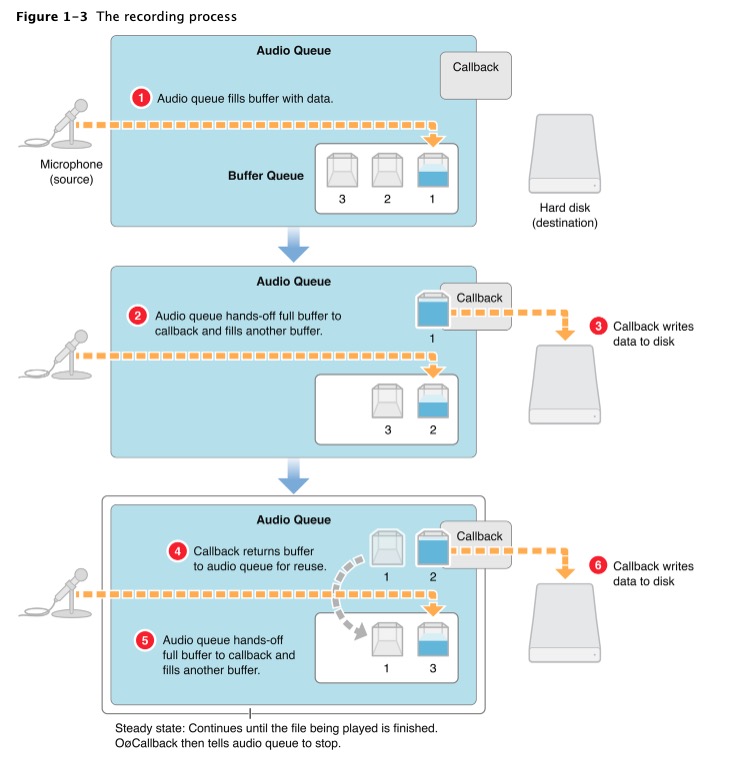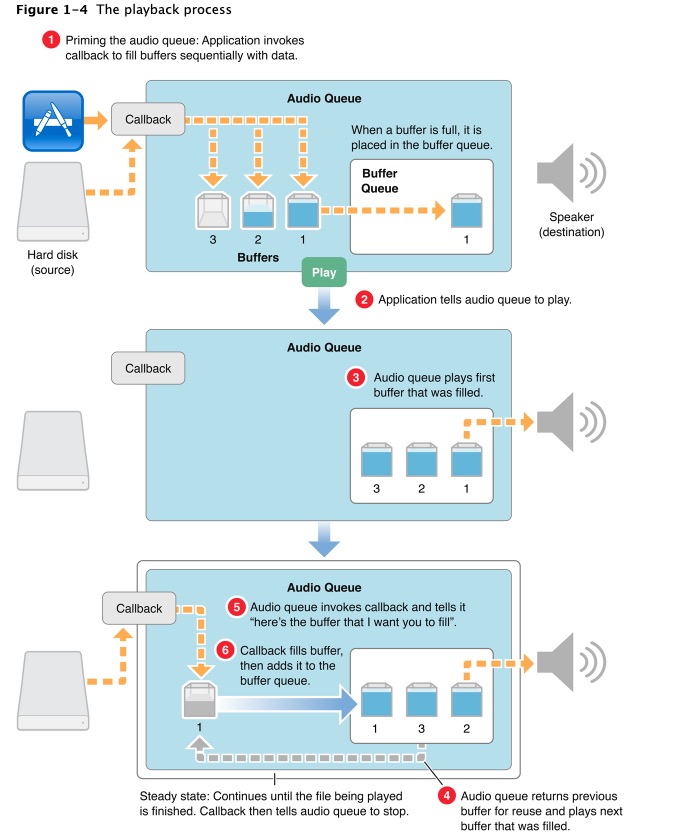这个文档会分为以下3个部分介绍Audio Queue Services:
- audio queue,它是一个在AudioQueue.h中的。用来连接硬件(麦克风和扬声器),管理内存(buffer的enqueue和消费),控制播放和采集。
- audio queue buffers,audio queue中的内存对象,音频数据和长度存在里面。
- audio quque callback,一个和audio queue绑定的回调,录制的时候,回调告诉你取音频数据;播放的时候,回调告诉你填充数据。
可以将硬件、audio queue、callback看成是一个圆环上的3个点,它们在不停的按照某一个方向在传输数据,buffer就是装数据的容器。
这里简单介绍一下录制的时候audio queue和硬件以及callback交互的步骤:
- 硬件采集音频数据,将它填充到空的buffer中
- audio queue将填充的数据告诉callback,硬件继续采集音频数据
- 在callback中可以将数据存起来或者发送给其他人
- callback使用完数据后将buffer重新放到缓冲区中
- audio queue将空的buffer放在队列的末尾,等待再次使用,硬件继续采集音频数据
- audio queue将新的填充满的数据告诉callback
- (instancetype)init {
if (self = [super init]) {
_queue = dispatch_queue_create("zf.audioRecorder", DISPATCH_QUEUE_SERIAL);
[self getAudioSessionProperty];
[self setupAudioFormat];
dispatch_async(_queue, ^{
[self setupAudioQueue];
[self setupAudioQueueBuffers];
});
}
return self;
}为了确保顺序,这里我们创建了一个串行队列来处理任务。 初始化的时候,先通过AVAudioSession获取当前设备的采样率和处理间隔。然后根据获取的参数计算合适的buffer大小。
- (void)setupAudioFormat {
UInt32 mChannelsPerFrame = 1;
_asbd.mFormatID = kAudioFormatLinearPCM;
_asbd.mSampleRate = _sampleRate;
_asbd.mChannelsPerFrame = mChannelsPerFrame;
//pcm数据范围(−2^16 + 1) ~ (2^16 - 1)
_asbd.mBitsPerChannel = 16;
//16 bit = 2 byte
_asbd.mBytesPerPacket = mChannelsPerFrame * 2;
//下面设置的是1 frame per packet, 所以 frame = packet
_asbd.mBytesPerFrame = mChannelsPerFrame * 2;
_asbd.mFramesPerPacket = 1;
_asbd.mFormatFlags = kLinearPCMFormatFlagIsSignedInteger | kLinearPCMFormatFlagIsPacked;
}- (void)setupAudioQueue {
void *handle = (__bridge void *)self;
OSStatus status = AudioQueueNewInput(&_asbd, inputCallback, handle, NULL, NULL, 0, &_audioQueue);
printf("AudioQueueNewInput: %d \n", (int)status);
}这里的AudioQueueInputCallback是一个c的函数,我们可以把self作为一个指针传进去。
- (void)allocateBuffers {
_bufferSize = _sampleRate * _sampleTime * _asbd.mBytesPerPacket;
for (int i = 0; i < kNumberBuffers; ++i) {
AudioQueueBufferRef buffer;
OSStatus status = AudioQueueAllocateBuffer(_audioQueue, _bufferSize, &buffer);
printf("recorder alloc buffer: %d, _bufferSize:%u \n", (int)status, (unsigned int)_bufferSize);
mBuffers[i] = buffer;
}
}- (void)startRecord {
[self checkAudioAuthorization:^(int code, NSString *message) {
NSLog(@"checkAudioAuthorization code: %d, message: %@", code, message);
}];
dispatch_async(_queue, ^{
[self enqueueBuffers];
//start audio queue
OSStatus status = AudioQueueStart(self.audioQueue, NULL);
if (status == noErr) {
self.isRunning = YES;
}
printf("AudioQueueStart: %d \n", (int)status);
});
}我们要开始录制了,录制前我们还是先检查权限。然后将空的buffer放到队列中供audio queue填充数据。
- (void)stopRecord {
dispatch_async(_queue, ^{
//stop audio queue
OSStatus status = AudioQueueStop(self.audioQueue, true);
if (status == noErr) {
self.isRunning = NO;
}
printf("AudioQueueStop: %d \n", (int)status);
});
}static void inputCallback(void * inUserData,
AudioQueueRef inAQ,
AudioQueueBufferRef inBuffer,
const AudioTimeStamp * inStartTime,
UInt32 inNumberPacketDescriptions,
const AudioStreamPacketDescription *inPacketDescs) {
ZFAudioQueueRecorder *recorder = (__bridge ZFAudioQueueRecorder *)inUserData;
if (recorder.isRunning == NO) {
return;
}
//消费音频数据
if ([recorder.delegate respondsToSelector:@selector(audioRecorder:didRecoredAudioData:length:)]) {
[recorder.delegate audioRecorder:recorder didRecoredAudioData:inBuffer->mAudioData length:inBuffer->mAudioDataByteSize];
}
//将buffer给audio queue
OSStatus status = AudioQueueEnqueueBuffer(recorder.audioQueue, inBuffer, 0, NULL);
if (status != noErr) {
printf("recorder enqueue buffer: %d \n", (int)status);
}
}这里取到数据后使用代理的方式将数据传递出去,然后立即将使用后的buffer入队
这里简单介绍一下播放的时候audio queue和硬件以及callback交互的步骤:
- 应用主动调用callback,将buffer给audio queue
- audio queue开始工作
- audio queue将填充的音频数据交给播放器播放
- audio queue判断如果还有数据,继续播放下一个buffer
- audio queue将空的buffer告诉callback需要填充数据
- callback填充完数据,然后将buffer入队
- (instancetype)init {
if (self = [super init]) {
_queue = dispatch_queue_create("zf.audioPlayer", DISPATCH_QUEUE_SERIAL);
[self getAudioSessionProperty];
[self setupAudioFormat];
dispatch_async(_queue, ^{
[self setupAudioQueue];
[self setVolume:1.0];
[self allocateBuffers];
});
}
return self;
}步骤基本和录制的时候一致。
- (void)setupAudioQueue {
void *handle = (__bridge void *)self;
OSStatus status = AudioQueueNewOutput(&_asbd, outputCallback, handle, NULL, NULL, 0, &_audioQueue);
printf("AudioQueueNewOutput: %d \n", (int)status);
}- (void)allocateBuffers {
_bufferSize = _sampleRate * _sampleTime * _asbd.mBytesPerPacket;
for (int i = 0; i < kNumberBuffers; ++i) {
AudioQueueBufferRef buffer;
OSStatus status = AudioQueueAllocateBuffer(_audioQueue, _bufferSize, &buffer);
printf("player alloc buffer: %d, _bufferSize:%u \n", (int)status, (unsigned int)_bufferSize);
buffer->mUserData = (void *)NO;
buffer->mAudioDataByteSize = _bufferSize;
mBuffers[i] = buffer;
}
}- (void)startPlay {
dispatch_async(_queue, ^{
[self enqueueBuffers];
//start audio queue
OSStatus status = AudioQueueStart(self.audioQueue, NULL);
if (status == noErr) {
self.isRunning = YES;
}
printf("AudioQueueStart: %d \n", (int)status);
});
}- (void)stopPlay {
dispatch_async(_queue, ^{
//stop audio queue
OSStatus status = AudioQueueStop(self.audioQueue, true);
if (status == noErr) {
self.isRunning = NO;
}
printf("AudioQueueStop: %d \n", (int)status);
});
}
- (void)putAudioData:(void *)data length:(UInt32)length {
if (!_isRunning) {
return;
}
//这里处理的有点粗糙,音频数据可能会乱
AudioQueueBufferRef fillBuffer = NULL;
for (int i = 0; i < kNumberBuffers; ++i) {
AudioQueueBufferRef buffer = mBuffers[i];
BOOL bufferFiled = (BOOL)buffer->mUserData;
if (!bufferFiled) {
fillBuffer = buffer;
break;
}
}
if (fillBuffer == NULL) {
printf("没有可用buffer, 执行丢帧 \n");
return;
}
memcpy(fillBuffer->mAudioData, data, length);
fillBuffer->mAudioDataByteSize = length;
fillBuffer->mUserData = (void *)YES;
}这里需要注意,我使用了audio queue的buffer做为音频的缓冲区,如果录制回调和播放回调不是同步的话(和系统有关)可能会丢帧导致音效不太好的情况。
static void outputCallback(void *outUserData,
AudioQueueRef outAQ,
AudioQueueBufferRef outBuffer) {
ZFAudioQueuePlayer *player = (__bridge ZFAudioQueuePlayer *)outUserData;
if (!player.isRunning) {
return;
}
if (player.playIndex >= kNumberBuffers) {
player.playIndex = 0;
}
AudioQueueBufferRef filledBuffer = player->mBuffers[player.playIndex];
memcpy(outBuffer->mAudioData, filledBuffer->mAudioData, filledBuffer->mAudioDataByteSize);
outBuffer->mUserData = (void *)NO;
OSStatus status = AudioQueueEnqueueBuffer(player.audioQueue, outBuffer, 0, NULL);
if (status != noErr) {
printf("play enqueue buffer: %d \n", (int)status);
}
player.playIndex ++;
}playIndex是为了保证按顺序enqueue buffer。

